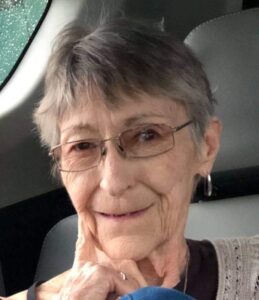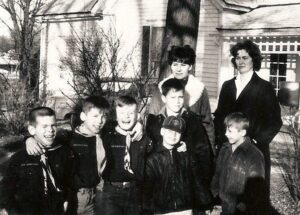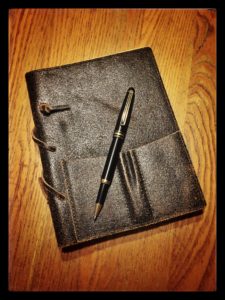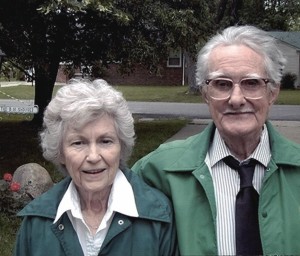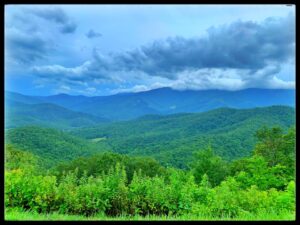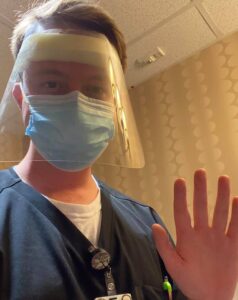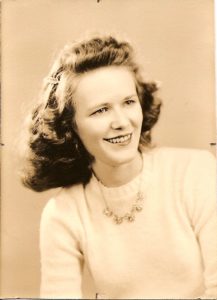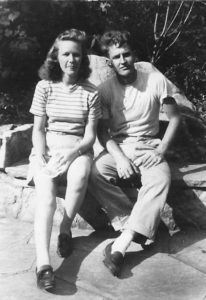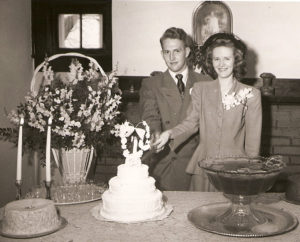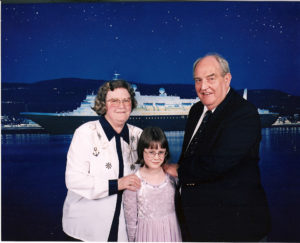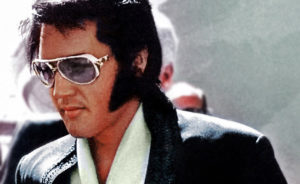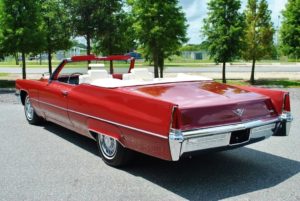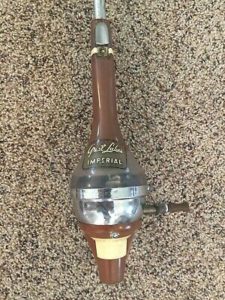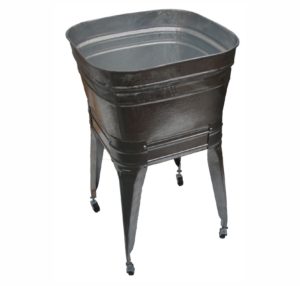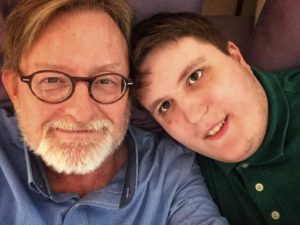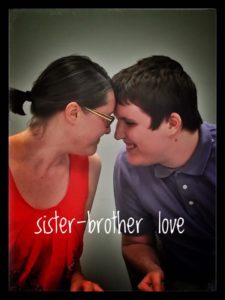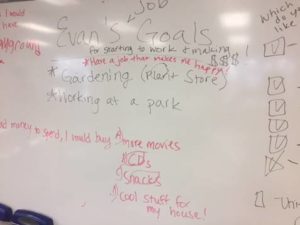As the title of this piece says, it’s Part II. If you haven’t read Part I, you might want to go back and read that for context. I hope you enjoy this. It’s been quite a while in the making, and I’m feel like I’m leaving so much out. But it feels *right* to go ahead and post it now. Be sure to click on the photos for a larger view. And on the blue links for clippings and other images.
Now I want to shift gears just a bit to tell a remarkable story about ANOTHER young man who was born in Mexico, over a hundred and twenty years ago, and who had dreams of his own. I strongly suspect this story, Leonard’s story, has never ever been told in just this way…. and probably could NOT have been told at any other time in history than now. Due to the power of the internet to connect threads, and random bits and pieces of “ordinary” history, it’s possible to piece together narratives that are remarkable and moving and meaningful, even if incredibly obscure.
To set the stage, I need to go back to Part I of this story, and that very kind gentleman who loaned me the fifty cents that day for the summer movie at the Liberty Theater. Alan Coatsworth didn’t just “happen” to be sitting there in that lumber company office. He was born into it.
He was the fourth generation of Coatsworth lumber men in Mexico. Before him, his father, Alan Coatsworth Sr. (1896-1977), was in the lumber business in Mexico, as was his grandfather Frank Whitfield Coatsworth (1860-1939), and his GREAT grandfather Ralph Musgrove Coatsworth (1808-1889).
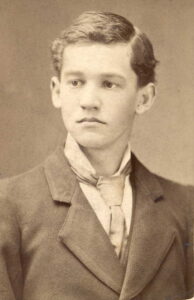
Frank W Coatsworth, c.1872
In May of 1889, Frank W. Coatsworth, the second generation Mexico lumberman married Ida Lee Myers, and together they took up residence on East Promenade Street. They would eventually have five children, William Myers Coatsworth, Ralph Coatsworth (named for his grandad), Leonard Broughton Coatsworth, Alan Coatsworth, and a daughter, Helen Coatsworth. As stated before, Alan Sr. would succeed his father in the lumber business in Mexico. Their lumber-yard in those days was on West Love Street, on both sides of Jefferson Street, just a block north of the downtown square. A couple of the other brothers stayed in the area as well. But it is Leonard, who was born in 1895 that I want to focus on.
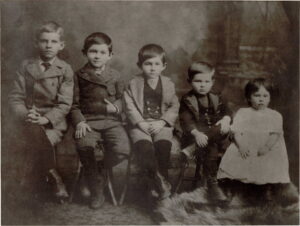
Coatsworth children. Leonard in the Middle
Leonard was never destined for a life selling wood and nails and building supplies, even as noble as that profession is. As we shall see, Leonard dreamed of adventure, and adventure indeed would come his way.
Leonard was a precocious child, always doing well in school. All the Coatsworth children did well in school, but Leonard was exceptional. He was drawn to words, and to reading. He had an affinity for science as well, but it was always words that drew his interest most powerfully. He also was known well to be the jokester of the family, and he loved to make people laugh.
However, before we get ahead of Leonard’s story, and looking at some of the specific events in and around Mexico and the world that would shape Leonard’s life, let’s take a moment to get some perspective on the age into which he was born.
More so than perhaps any time in the history of mankind up until then, the late 1800’s and first few decades of 1900’s were a truly magical time to be alive. The world was changing so incredibly rapidly … far more rapidly than at any time in history. The pace of innovation and invention was just astounding. And the people then were quite aware of this fact.
For a kid to be alive and witnessing all of the changes around him must have been one almost fantastical amazement after another. The invention of the automobile, the rise of industrialization in towns and cities of all sizes (not just the big urban centers), Orville and Wilbur Wright making their first man-powered flight in 1903, the electrification of our cities and towns, the development of wireless telegraphy, the dawn of the telephone age, … the list goes on and on. In the late 1880s most of these things either did not exist, or were so rare as to be unfamiliar to common folk. A couple of decades later, they were beginning to be seen everywhere. Since there were few if any “moving picture shows” yet, (and therefore no movie theaters), no TV, no internet … both kids and adults had to find their entertainment where they could. Mexico had a grand Opera House that held regular productions and public lectures, and an open-air venue where more “ordinary” entertainments could be had. But the opportunities were limited.
One thing the families in Mexico in the early years of the last century could count on was the Chautauqua. Chautauqua was an adult education movement, and was highly popular in the late 19th and early 20th centuries. It brought both entertainment and culture for the whole community, with speakers, teachers, musicians, entertainers, preachers and various “specialists” or experts in their given field of study.
And yes, Chautauqua came to Mexico in the summer of every year in those days.
From the book “Traveling Culture: The traveling Chautauqua in the twentieth Century”, comes this definition:
“What was Chautauqua? Theodore Roosevelt called it “the most American thing in America,” Woodrow Wilson described it during World War I as an “integral part of the national defense,” and the politician and orator William Jennings Bryan deemed it a “potent human factor in molding the mind of the nation.” Conversely, Sinclair Lewis derided it as “nothing but wind and chaff and… the laughter of yokels,” William James found it “depressing from its mediocrity,” and critic Gregory Mason dismissed it as “infinitely easier than trying to think.”
However Chautauqua was characterized, it elicited strong reactions and emotions.” It goes on to say that, “There are few Americans left who remember the Circuit Chautauqua but there was a time when those words conjured up a host of images. To its supporters it meant a chance for the community to gather for three to seven days to enjoy a course of lectures on a variety of subjects. Audiences also saw classic plays and Broadway hits and heard a variety of music from Metropolitan Opera stars to glee clubs to bell ringers. Many saw their first movies in the Circuit tents. Most important, the Circuit Chautauqua experience was critical in stimulating thought and discussion on important political, social and cultural issues of the day…… Lecturers were the backbone of Chautauqua. Every topic from current events to travel to human interest to comic storytelling could be heard on the Circuits. Chautauqua would swell by the thousands to see William Jennings Bryan, the most popular of all Chautauqua attractions. Until his death in 1925 his populist, temperance, evangelical, and crusading message could be heard on Circuits across the country. Another popular reformer, Maud Ballington Booth, the “Little Mother of the Prisons,” could bring her audiences to tears with her description of prison life and her call to reform. In a more humorous vein, author Opie Read’s homespun philosophy and stories made him an enduring presence on the platform. . Music was also a staple on the Circuits and bands were particularly popular. The band most identified with the Redpath Circuit (which came regularly to Audrain County) was Bohumir Kryl’s Bohemian Band. Kryl, a protégé of John Philip Sousa, and his band were famous for their memorable version of the “Anvil Chorus” (Il Trovatore). Included were “four anvils with four husky tympanists in leather aprons….as the hammers clanged down on the anvils, an electric device sent sparks cascading around the darkened stage.”
Any way you look at it, Chautauqua, was quite the spectacle. And judging from the newspaper accounts of the day, it was just considered the thing to do when Chautauqua came to town to alter your plans and attend. And many town people would buy a weekly ticket, and attend EACH night, all week long of the Chautauqua’s run in the city.
A mentioned above, Mexico was a regular stop for the Chautauqua circuit during those early years of the century, and the Coatsworth family, with Frank being a leading businessman in the city, attended every year. Coatsworth Lumber was one of the advertisers in the Chautauqua programs.
For many years, Chautauqua would set up in a vacant field on the north end of Eastholm street, not far from the railroad tracks. A regular rail shuttle from the downtown depot carried Mexicoans out to Chautauqua and back again each evening. The location on Eastholm would have been easy walking distance for the Coatsworth children from their home on East Promenade.
One of the frequent speakers on Chautauqua circuit, including on those trips to Mexico, was a man considered one of the greatest orators of all time, William Jennings Bryan. He brought populist and evangelical messages to the crowds, addressing topics such as temperance, and personal responsibility.
It is a matter of record that Mr. Bryan on his Chautauqua lectures also often waxed eloquently on the issue of the “Single Tax”. His talks on the subject included at least one occasion in Mexico that was reported in the Mexico Weekly Ledger. More on that issue later, but for now, back to Leonard’s story…..
Leonard Coatsworth, as mentioned before, was a precocious child and a good student. He was interested at an early age in words, and language, and this early talent would serve him his entire life. He also had quite a sense of humor.
In high school at McMillan High School in Mexico, he was a star on the debate team, and under his leadership that team handily raked up a near perfect record. In fact, during Leonard’s high school years, the Mexico debate team was regularly regarded as among the best high school debate teams in the entire state of Missouri. Not just Leonard, but his good friend and classmate Morris Dry, were the stars on that team. One of their topics of debate, as reported by both the Mexico Missouri Message, and the Mexico Weekly Ledger, two of the town’s three newspapers, was the question of “Single Taxation”.
The “Single Tax”, basically is the notion that taxes levied locally upon the assessed value of personal property (land) could and SHOULD be sufficient to provide one-hundred-percent of the operating capital required by counties and municipalities. The opposing view was that it was entirely appropriate to consider OTHER taxes as a means of municipal revenue as well….. sales taxes, usage taxes for things like vehicles, etc., and even the very controversial notion of some sort of an “income” tax.
The way the debate process worked (then as now), the debate teams needed to study an issue, both sides, and be prepared to be randomly selected to argue either side of the issue. Leonard seemed to have a particular affinity for arguing in the affirmative. I’m sure the actual debates were every bit as scintillating as it sounds.
In actuality, the question of the “Single Tax” was one of the foremost political issues of the day. Political campaigns would be waged, won and lost on this issue. It would be akin to today’s students debating capital punishment or abortion, or a national mandated health-insurance, or any one of several other “hot button” issues.
In 1910, when Leonard was still in school in Mexico, there was a great visitation that caused quite a stir: Halley’s Comet. As it happens, the historical record shows that the 1910 appearance of the comet was probably one of the brightest and most spectacular ever, given that it is also one of the closest approaches the comet has ever made to the earth.
Now, one can look back easily in history and see that by using hindsight, the previous appearances of the great comet once every 76 years, were (with suitably vague and loose interpretation) often in historical proximity to some great cataclysmic event… Halley’s Comet of 1066 was hanging in the sky for two months while the English and Normans were planning for an invasion. At the Battle of Hastings a few months later the Normans emerged as victors and from that time on the comet was said to have been a sign that favored the descendants of William the Conqueror. In 1456, Pope Calixtus III condemned the appearance of the comet as an evil omen, as the Ottoman Empire had defeated Europe just a year or so prior to the comet. The comet of 1665 was believed by some in the next decades to have been responsible for the Black Plague that killed 90 thousand people in London. The appearance of Halley’s Comet in 1835 was blamed for a number of things, including the fall of the Alamo, the destruction of 530 buildings in New York City because of a fire that raged for several days and nights, the massacre of over 280 people in Africa by ten thousand Zulu warriors. The common sense we bring to bear on these things now in the 21st century makes those notions seem provincial, and even almost comical.
From “Comet Hysteria and the Millenium” by Gary W. Kronk:
“With the invention of newspapers, the telegraph, and the telephone came an increase in communication between people. Although doomsayers have always existed, this opened up a new avenue for them to pass their word to others. Perhaps the first major test of this came with the appearance of Halley’s Comet in 1910.
A little bit of scientific information in the wrong hands can be dangerous. During the latter half of the 19th century astronomers had developed a tool that enabled them to analyze the light being reflected by comets. One of the first discoveries was that comets reflected sunlight, which makes a lot of sense to us nowadays since we know comets do not emit light, but this did surprise of lot of people. Interestingly, however, bright comets would actually reflect sunlight as it passed through their own dense clouds of dust and gas. This allowed astronomers to begin determining what comets were actually made of. One of the earliest discoveries was that comets contained cyanogen, a very poisonous gas.”
As Halley’s Comet approached the sun in 1910, astronomers announced that Earth would actually pass through the tail of this comet during May of that year. The scientists assured everyone that Earth was completely safe and suggested that at best, the comet’s visitation might lead to the possibility of some spectacular sunsets. Meanwhile however, the doomsayers latched onto a potential link: If comets contain a poisonous gas and if Earth is going to pass through the comet’s tail, then the people of Earth were surely in serious danger! Numerous newspapers actually published this story. Astronomers countered by saying the material in the tail was so spread out that there could be no ill affects, but few newspapers published this accurate information. Interestingly, a minor panic arose in some cities and entrepreneurs took advantage of it. They sold “comet pills” which were said to counter the effects of the poisonous gas. The pills sold like crazy. On May 20, after Earth had passed through the tail, everyone who had taken the pills was still alive…but, then, so was everyone else.”
My hometown of Mexico, Missouri was not immune to the influence of those who wished to take advantage of this “Comet Hysteria”. Some newspaper ads and stories of the day warned people that it might be best to stay indoors during the peak of comet visibility. Some merchants sold those pills, or gas masks, or even a “comet helmet” that was supposed to protect one from …from …. well from “something”. The vagueness of the claims magnified the fear, and fear itself was the main selling point.
Then in the May 26th, 1910 issue of the Mexico Missouri Message, shortly after the peak of the comet visibility, we find this small article:
“The graduating exercises of the graded schools were held Saturday night. The valedictorians were: Mildred Pearl, south side; Anna Caldwell, north side. The following essays and orations which were interspersed with music were given: ‘Halley’s Comet” by Leonard Coatsworth; “Boy Achievements” by Morris Dry; “Suffer Yet and Suffragette” by Miriam Glandon; “The Experiences of two Circulating Library Books,” by Mabel Threlkeld; “Missouri,” by Orlando Worrell; “The Schools of Other Lands” by Mildred Pearl; and “Burgoyne’s Campaign,” by Wallace Mathews.”
One wonders what, in the aftermath of the biggest uneventful “doomsday“ scenario that any of these people had ever known, what sorts of wry observations the precocious young jokester Leonard, age 14, might have come up with? One may get an idea, by imagining what a 9th grade commentator known for his sense of humor might have said at the end of 2012 when the so-called “Mayan Apocalypse” did not come to pass and the world did NOT end as “predicted” by the big Mayan calendar rock.
Whatever it was specifically that Leonard said to the assembled that evening is lost to history, but given his emerging talent for oration and his known sense of humor, one can suspect it may have had the crowd laughing along.
In 1907, in England, General Robert Baden-Powell founded the Boy Scouts. A Chicago Publisher, W.D. Boyce, had made a trip to London. On the foggy streets, he lost his way, and encountered a young man in a uniform who came to Boyce’s aid. This “Unknown Scout”, as Boyce would later immortalize him, guided him to his destination. The boy then refused Boyce’s tip, explaining that he was a Boy Scout and was merely doing his daily good turn. Soon thereafter, intrigued by this notion of a veritable army of young men out doing good deeds in uniform, Boyce met with General Baden-Powell, and told him of his encounter.
On February 8, 1910, the Boy Scouts of America was incorporated. Only a short seven months later, plans for a Boy Scout troop came to Mexico! It was one of the very earliest troops of Boy Scouts in small town Missouri. As reported in the Message on September 29, 1910:
“Mexico has organized a company of Boy Scouts. And if the youngsters grow to be nothing more than gentlemanly men to the Hardin College girls, their organization will have been justified.”
Among the very first group of boys to join the Mexico troop of Boy Scouts when it was begun in earnest early the next year, one of the first troops in Missouri, was none other than Leonard Coatsworth.
As the boys gathered together at their troop meetings, they learned their orienteering skills, and about knots and about survival outdoors, as scouts of today do. But they also talked about the ways in which the world was changing, and about the latest inventions of the day. Among them, some few boys were keenly interested in wireless telegraphy. A few months later, from the March 7, 1911 Mexico Ledger:
“Mexico will soon be the center of a youthful club of wireless telegraph experimenters. Leonard Coatsworth and Willie Greer, the first boys to begin experiments with wireless, are meeting with so much success several others are preparing to procure outfits. Among the new boys that will join the club is Russell Moore, son of R.D. Moore, the well-known horseman. He will install a wireless outfit at his home a mile and a half east of this city.”
Even more remarkably, Leonard conceived of a plan to build a PORTABLE wireless station that could be used by the Boy Scouts ….. attaching the set to any barb-wire fence to use that as an aerial to pick up signals being sent from any base station miles away. Being among the first to experiment with an exciting new technology must have been pretty amazing stuff for Leonard and his friends. It seems to not be dissimilar to a young Steve Jobs and Steve Wozniak building a computer in their garage, excitedly joining in with a few other enthusiasts. Doing it precisely BECAUSE it was new and exciting, and because they were just looking for some kind of adventure, and saw a potential in it.
From June of 1912, a notice appeared in the Mexico Ledger about a Boy Scout encampment at their “new cabin” north of Mexico. This encampment would have been just beyond present-day Plunkett Park.
BOY SCOUTS TO BE IN CAMP JULY 8 to 11,
AT THEIR CABIN NORTH OF MEXICO.
No Guns, No Drinking Creek Water, and Other Prohibitions.
“The Boy Scouts at Mexico will go on their annual camp July 8 to 11, at their new cabin 4 miles north of town, on the electric railroad. A scoutmaster will be in charge all the time, although the camp will be practically in charge of the scouts. No guns will be allowed in camp and every effort will be made to keep the camp sanitary at all times. The boys are warned against drinking creek water. The parents of the boys and the Scout Council are invited to be present on the last day for dinner and to witness the athletic events. Others interested are invited for the afternoon events. Boys, who intend going, must report to P.L. Hanly at once. “
In reporting on the grand encampment, this story ran couple weeks later, on July 11, 1912, in the Message:
THE BOY SCOUTS.
Having a Big Time at Their Camp North of Mexico.
The Boy Scouts of Mexico, numbering about 40, went into camp at their cabin, on the banks of Salt River, last Monday. Morris Dry, Patrol Leader, officer in command and having general charge of details.
The boys are having the time of their lives. Water baseball is one of the great fun-making diversions. Tuesday, Lee Richards landed a big catfish, weighing three pounds, his first catch. The catch caused great excitement in camp. There are six tents on the grounds besides the cabin is occupied also. Athletics is the program for today. Parents of Scouts invited for dinner. The Wellsville Scouts will also be present as guests. Three classes of Scouts will take part in the following events today:
50 Yard Dash.
Running Broad Jump.
Running High Jump.
Pole Vault.
Swimming Race.
Fire Building
Race to Boil Water.
First Aid Competition.
A medal will be given to the boy making the most points in the athletic events; for the best showing in First Aid and the patrol making the best showing will be given a special patrol flag. Among those in camp from Mexico are: Roy Ferris, Mitchell White, Rev. A. A. Wallace, Dr. H.W. Gibbs, R. Chandler, Chas. Kunkel, Hall Pearson, Maurice Pearson, Gibson Winans, John Million, Archie Rodgers, Tom Reed, Frank Morris, Orville Austin, Robert Cordner, Guy Holliday, Russell Lewis, Maas Rowland, Morris Dry, Eric Cunningham, Theo Winans, Roselle Haskell, Frank Kunkel, Orval Staples, Lee Richards, John Dearing, Mason Guthrie, Blake Williams, Leonard Coatsworth, Joel Guthrie, W. F. Bridgford, Harry Rose, Ross Ferris, Edwin Winans, Richard Harth, Ray Highbreeder, Ross Gallop, and Frank Boatman.
So there’s Leonard again, right in the middle of grand adventure with his Boy Scout troop, with his buddy Morris and several other friends. One can imagine the plans and escapades being dreamed up by Leonard Coatsworth and his scouting buddies at that encampment.
Around the fire those evenings, those boys made plans for other camping and hiking adventures. They talked about the world, and how it was changing. One of them, maybe even it was Leonard, may have wondered if it were possible to hike from Mexico all the way to St. Louis, and if so, how long it would take? It’s very likely that most of the boys had never been to St. Louis, never seen a city with tall buildings. Maybe none of them had. If so, it would almost certainly have been on an excursion with family by train. We can be pretty confident in our guess that this was a topic of conjecture, because before long, that’s exactly what a small group, a group LED by Leonard Coatsworth himself, purposed to do. To hike from Mexico all the way to St. Louis.
Keep in mind; this was in the days LONG before the Interstate Highway System, and even before any major US Highways. There were barely any automobiles on the roads. Seeing one was more of a rarity and a curiosity than it was a usual occurrence. So the way from Mexico to St. Louis would certainly have contained long stretches that were not paved, and it was probably not all that direct. Undertaking that trip, even with some sort of a horse-drawn conveyance, was not something one did lightly. On foot was a bold and adventurous leap of faith.
Yet, from the August 5, 1911 edition of the Mexico Ledger, we read this:
“A telegram from Leonard Coatsworth to Roy Ferris on Saturday afternoon states the three Boy Scouts who departed from this city Thursday to tramp to St. Louis arrived at Truesdale at 9 o’clock Saturday morning. The message states they will reach St. Charles on Sunday morning. All are well and the three boys are making good progress.” (Truesdale, fyi, is near Warrenton).
Their news of their trip eventually reached a wider audience, for from the September, 1911 edition of Boys Life Magazine, the national magazine of scouting, comes this brief from Missouri:
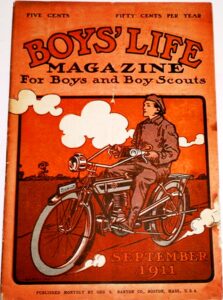 “Boy Scouts End Hike – Three Youthful Hikers Cover Distance from Mexico, MO to St. Louis in Four Days.
“Boy Scouts End Hike – Three Youthful Hikers Cover Distance from Mexico, MO to St. Louis in Four Days.
Clad in Khaki, and carrying neatly rolled camping outfits, three boys entered the office of Henry Clay Thompson, Jr., Boy Scout Commissioner for St. Louis, Monday afternoon. Leonard Coatsworth, 16 years old, was their leader. He introduced himself to Thompson, and standing erect, at attention, said – “Scout Commissioner Thompson. We are instructed to bear you, as representative of the Boy Scouts of St. Louis, a greeting from Troop A, Boy Scouts of Mexico, Missouri, and best wishes for your success!” “Thank you,” Thompson answered cordially. The three boys, Coatsworth, Minter Bragg, 16, and Kenneth Sanford, 17 years old, left Mexico Thursday morning, and walked the 147 miles to the city limits here. They finished their Tramp, Monday noon.”
That’s 147 miles of hiking in 4 days, or an average of almost 37 miles per day. While there in St. Louis, they were “given their freedom of the fine Y.M.C.A building there.”
It doesn’t say whether they also walked home. I’d like to think maybe Leonard’s dad Frank, the Mexico lumber man, sprang for train tickets for the boys to ride home in style, to a hero’s welcome back at the same depot that would be part of my own childhood, over fifty years later. But 37 miles a day for 4 days! My long trail hike was about 22 miles… less than HALF that. And I remember being worn out. These boys did 37 miles a day for four days straight! Presumably with knapsacks for sleeping rolls, mess kits, food, etc.
As fun as Boy Scouts must have been, it’s not ALL that Leonard Coatsworth was interested in. As previously mentioned, he was a wordsmith, a debater, and a skilled orator. The following is from the December 26th, 1912 edition of the Message:
The Juniors of McMillan High School entertained the student body and faculty last Friday afternoon with a Christmas tree and literary program. The gymnasium, where the exercises were held, was beautifully decorated in appropriate colors. A herald was sent to the different classrooms, who invited the students to partake of the hospitality of the Juniors. The program was opened by an address of welcome by the Junior President, George Irion. Leonard Coatsworth made a spirited oration against the “crystallized bureaucracy” of the Faculty. Anna Caldwell gave a humorous oration on “Fashions,” and Mabel Threlkeld, carrying a suffragette banner, advocated woman’s rights” with true suffragette vigor. The debate also was very humorous. The question was, Resolved that the Jesse tribe should be forced to pay the “Single Tax” or be exiled from the country. The affirmative was represented by Morris Dry, Mildred Pearl, Percie Fuhrer and Alma Shoush. The “Jesse Tribe”, represented by Morris Rodes and Louis Jesse, ably espoused their own cause. The last number on the program was a travesty on “Macbeth” by the following: Macbeth, Hubert Warden; Banquo, John Creigh; King Duncan, Oscar Haskell; Three Witches, Frances Pearl, Lucile Kunkel, LeRein Warden; Herald, Halley Bradford. After the program Santa Claus emerged from the chimney and distributed his presents. The Freshmen, who were seated in the balcony, received their presents from a baby carriage, which ran on a track just outside the balcony.
Hmmmmm…. “a spirited oration against the “crystallized bureaucracy” of the Faculty”. I would have loved to have been there for that speech.
Then, from April 13, 1913:
“Leonard ‘Coatsworth and Chas. Wright, representing the Mexico High School, debated against the Marshall High School team last Friday night. They discussed the Single Tax question, the Mexico debaters favoring the question, and the Mexico debaters came off victors for the single tax – and what do you think of that?”
As a senior at McMillan High School, Leonard was quite active in the class. He was not only a skillful debater, but was also featured prominently in the Senior Class play, “The Dictator” and was listed among the cast who “did honor to themselves and their class by their skillful individual interpretations”. At the Senior Class graduation banquet, the “Address to the Class of 1914 was delivered by Miss Mary Dearing, Class of 1913”. However, the “Response” was delivered by Leonard Coatsworth, and was reported to have greatly regaled the attendees.
In the June 18 Ledger of that year, 1914, though he was set to attend the University of Missouri as a journalism student, it is reported that:
“Leonard Coatsworth has accepted a position of some responsibility with a big realty company in Taney County, MO. Leonard is all right, and will make good.”
Perhaps Leonard needed to earn the money for college. Perhaps he just wanted to gain some practical experience in the work-world before heading off to school.
In any case, by the first of the New Year, Leonard was in Columbia and ready for studies, just a bit later than his old high school classmates. In January of 1915 as a new freshman at Mizzou, it was Leonard the jokester that showed up before Leonard the scholar. Under the headline, “Seen Twice in One Picture” comes the following from January 19, 1915:
SEEN TWICE IN ONE PICTURE
Leonard Coatsworth, Freshman, Appears at Both Ends of Photograph.
The likeness of Leonard Coatsworth, a freshman in the College of Arts and Science, may be found twice in the panoramic view of the visitors here during Farmers’ Week, taken just east of Academic Hall. Mr. Coatsworth stood at’ one end of the bleachers, which had been erected for the accommodation of the crowd, and was photographed by the revolving camera. By hurriedly running around behind the crowd, he was able to take a seat at the opposite end before the lens of the camera pointed in that direction, and was again photographed when the camera reached that point. In the picture he is standing at the left side with a large book in his hand. He wore a cap and may easily be identified as the same person seated, with a large book in his hand, at the right side of the picture”
On June 3, of 1915, the Mexico, Missouri Message reports that “Leonard Coatsworth, a graduate of McMillan, son of Mr. & Mrs. Frank Coatsworth, is set to become a reporter at the Omaha (Neb) Daily News. Leonard is a fine boy and able. Success to him!!” The very same story was reported a little differently that same week in the University Missourian.
“Former Student Now on Omaha Paper – Leonard Coatsworth of Mexico, MO a student in the School of Journalism of the University this last year, has begun working on the Omaha Daily News. Coatsworth left school on account of poor health. He has also been working on the Des Moines Capitol. Next year he expects to return to the University. “
No mention of what the “poor health” might have been.
Just a few weeks later, June 24th, Leonard is back in Mexico:
“CLASS of ’14 – Enjoy Big Eats and Picnic at McMillan High. The graduates of McMillan High School of the class of 1914 enjoyed a “get-together” at the school building Thursday night. A night picnic in the country had been planned but the weather prevented. A luncheon was enjoyed and then all went to the Lyric. The chaperones were Misses Flemma Snidow and Frances Glandon. Among those in the party were Misses Nellie Noel, Mildred Pearl, Lucile Kunkel, Grace Lagenback, Alma Shoush, Louise Willard, Mabel Threlkeld, Nina Machin, Jessie Morris, and Messrs. Wm. Greer, Louis Jesse, George Irion, Clayton Snook, Halley Bradford, Leonard Coatsworth, and Morris Dry.”
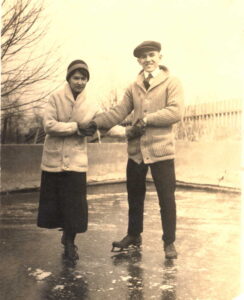
And ever the busy guy, Leonard “bought a booth under the grandstand” at the County Fair at auction in August of 1915. No word on what he was doing with the booth, but I feel confident it was interesting an drew a crowd.
Leonard enjoyed visits back in Mexico with his family when he was able. Here he is enjoying winter ice skating with his sister Helen in late 1915.
At the University of Missouri as a student in the School of Journalism, Leonard took a job in the Classified Advertising Department. There, Leonard and another Mexico boy, Charles Wright, started a new advertising venture called “Today’s Bargains“, where merchants could choose to feature something that would be on sale in their store the next day. They met with great success and earned some good money for the idea.
After his short stint at the Omaha paper, Leonard returned to the University in January of 1916, where he became Vice President of the “Audrain County Club”, a University organization of students from Mexico and Audrain County.
As the Spring semester came to a close, he took job for the summer of 1916 doing something seems right up his alley …. Travelling with the Chatauqua. From the Mexico Missouri Message of September 7, 1916:
“Leonard Coatsworth, son of Mr. and Mrs. Frank Coatsworth of this city, has been with the Redpath-Vawter Chatauqua System this summer. His company showed at Centralia last week.”
Chautauqua!! Leonard must surely have dearly loved it. Hearing the lectures and debates, going from town-to-town… Chautauqua must have been quite an adventure for a young man with Leonard’s talents and disposition.
That fall, though, Leonard was dutifully back in Columbia at University, and once again pursuing his journalism studies. Leonard had not given up his enjoyment of hiking in the years since his epic “tramp” to St. Louis. On November 15, 1916, comes this piece from the University Missourian:
“Marcus Asquith, Morris Keith, Sam Locke, Leonard Coatsworth, and Wentworth Seldon walked to Providence Sunday afternoon, going by way of Rock Bridge and Rutland. The seventeen miles were covered in about four hours.”
Seventeen miles …. just a leisurely Sunday jaunt for Leonard!
The next month, December of 1916, Leonard was again in University news, and back to his forte:
“Debate Squad Chosen. A final team of eight men was chosen last night to represent the University in a triangular debate with Oklahoma and Texas. These men, chosen from among the fifteen that had survived the preliminary elimination last Tuesday are: Leonard Coatsworth, Mexico, Morris Dry, Mexico, Fred Gableman, Kansas City, Frank Henzlik, Columbia, Frank Lowe, Kansas City, Nathan Scarritt, Kansas City, Fred Sudarth, Kansas City, and J.G. Umstadd, Columbia. The topic debated for the final selection was, “Resolved: That all state and local revenues should be drawn from a single tax on land values”. Six of the men took the negative of the question, two took the affirmative.”
Leonard and his hometown classmate and old debating partner Morris Dry, together again, and debating for the University team, the same issue they knew inside and out, the Single Tax. Talk about stacking the deck in Mizzou’s favor!!
Allow me to take a bit of a detour here to talk a little about that other Mexico boy I’ve mentioned a couple of times, Morris Dry, who was himself a remarkable young man and would go on to some notoriety of his own. In the September 13, 1917 Columbia Daily Missourian we learn that Morris had become Student Body President at Mizzou. The article says that Morris E. Dry, calling for “No Hazing” of incoming new students this upcoming school year. As context for where Morris’ spurning of the practice of hazing may have come from, read the clipping from the Mexico Message from the Fall of Morris’ Freshman year, September 1914 of his own hazing ordeal at the hand or rascally Sophomores.
Morris, of course was also a 1914 graduate of McMillan High School, along with Leonard Coatsworth. His father, J.W. Dry was the Mayor of Mexico, and up until 1913 the elder Mr. Dry also ran a hardware and farm implement business in Mexico. Morris, along with his buddy Leonard was a top debater while in high school on widely recognized McMillan High School debate team, and became a top debater at Mizzou as well.
After Morris graduated University, he enlisted in the Navy during WWI and became a Navy Pilot. Think about that. A WWI pilot. Another young Mexico man was also a pilot in WWI, Humphrey Craddock. That’s pretty remarkable, two pilots from one small town in Missouri in the First Morris was in fact so remarkable a pilot that he ended up going to Pensacola, FL where he trained Navy pilots to fly seaplanes. Think “Top Gun”, but over sixty years before “Maverick”.
At the end of the war, Morris went to Boston to go to Harvard Law School. After he graduated Harvard and passed the bar, he moved to New York City to practice law. He joined U.S. Rubber Company as an attorney in 1926, specializing in Anti-Trust law. He was a founding partner of the Arthur, Dry & Dole law firm. At some point in the late 1920’s he reconnected with home-town Mexico girl and classmate Barbara Johnson, who was also living in New York City at the time. Barbara was a graduate of Smith College and with a Masters from Bryn Mawr. They married in 1934. Barbara had also been trained at the Cordon Bleu culinary institute in Paris.
In 1942, Morris registered for the draft at the age of 45, and served the army as an attorney during WWII. Morris became General Counsel for the U.S. Rubber Company in the 1950’s, a position he held until his retirement in 1961. He died in 1990.
During his life, he became one of the most important and extensive collectors of old, original sheet music of American popular songs. He had amassed over 20,000 songs in sheet music, including some of the rarest copies of certain songs known to exist. One of these is the sheet music for “To Anacreon in Heaven”, from which Francis Scott Key got the tune for the Star Spangled Banner. Morris’ collection of sheet music is now housed as the “Morris E. Dry Collection of American Popular Music” at the American Music Research Center at the University of Colorado, Boulder. It is one of the most extensively accessed collections of sheet music by music historians today. Follow this link to read a retrospective on the legacy of Morris E. Dry and his sheet music collection. Absolutely remarkable.
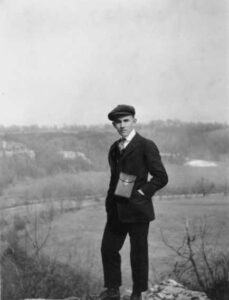
Leonard 2/17/1919
Now, back to Leonard’s story. 1917 would prove to be a year of big changes for Leonard. But the changes for Leonard would pale in comparison to the changes in store for the world itself.
In the spring of 1917, this VERY curious piece ran about Leonard in the University Missourian…. from March 20, 1917:
“Leonard Coatsworth, a student in the University, left today for Mexico, where he will clerk in a big hog sale tomorrow. He will return on Thursday.”
Clerk in a big hog sale?? Hmmmm. Wonder what that was all about?
Apparently though, Leonard’s sense of wanderlust was kicking back in…. judging from this piece from a month later, April, 5, 1917.
Journalism Student with Chautauqua
“Leonard Coatsworth, of Mexico, MO, and a junior in the School of Journalism has obtained a position with the Ellison-White Chautauqua Company, and has left Columbia for Kansas City, preparatory to beginning the trip. The circuit, which begins next week at Orange, Texas, will last five months, and will cover Texas, California, Washington, and other Western States.”
As Leonard traveled to Texas, California, and eventually to the Pacific Northwest, the world at large was in turmoil. The June 1914 assassination of Archduke Ferdinand of Austria, heir to the Austro-Hungarian throne and set to become one of the most powerful leaders in Europe … and not long after Leonard Coatsworth was graduating from McMillan High School … had plunged Europe into war.
In 1914, when war was declared in Europe, America under President Woodrow Wilson had adopted an official policy of “Neutrality and Isolation”. When news of trench warfare and the horrors associated with it reached the shores of America, it confirmed to many Americans that our government had adopted the right approach.
That approach had wide support of the majority of Americans – many of whom could not believe that civilized nations could descend into such depths as were depicted in the stories of trench warfare and the futility and horrors associated with such a strategy. The newspapers, including the hometown Mexico Ledger, reported in almost every issue, news of some new atrocity. Hand-to-hand combat, mustard gas attacks, random mortar shelling bringing devastation raining down from above … all these things were shocking and disturbing to the people over here reading about them.
So, America had tried to keep out of the conflict. But unrestricted submarine warfare, introduced by the Germans on January 9th, 1917, and which included the sinking of American ships, was the primary issue that caused Woodrow Wilson to ask Congress on April 2nd to declare war on Germany. Four days later, on April 6th, 1917 America joined World War One on the side of the Allies.
That was the very day after the April 5th newspaper story about Leonard rejoining the Chautauqua.
So the summer of 1917 wore on, with Leonard traveling the country with Chautauqua. Going from town to town, he undoubtedly heard continually in each new city about local boys joining up right and left everywhere the Chautauqua went.
Soon the news reached Leonard on the road that all three of his brothers back home had joined up as well. At many of those Chautauqua stops, he may have even seen the long lines at enlistment centers. As a budding newspaper man from his University experience, Leonard bought local papers at each stop, and read with a heavy heart the long lists of names of boys who had registered and joined up from each new town on the circuit. The news of the war weighed heavily on Leonard. With his nation at war, friends, and classmates …brothers … enlisting apace, Leonard knew the time had come for him to act.
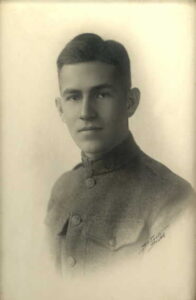
Leonard’s Army Photo
In the August 19, 1917 edition of the University Missourian, comes this story:
“Leonard Coatsworth Into Army. – Leonard Coatsworth of Mexico, a student in the University last year, is a member of the medical branch of the regular army. He is now at Recruit Barracks, Fort George Wright, Spokane, Wash. He resigned his position as advance man for the Ellison-White Chautauqua Company to enter the army.”
Why he decided to enlist in the Medical Corps is a mystery, but after some basic training in the state of Washington, Leonard was transferred to Fort Riley, Kansas to get his training as a battlefield medic, learning to treat the most horrific of injuries seen in battle. After that basic medic training, he was transferred BACK to Washington State, to Fort Lewis just outside of Tacoma, as a Medic with the United States Hospital Corps. He was assigned to the 91st Army Infantry Division, and stationed at Fort Lewis.
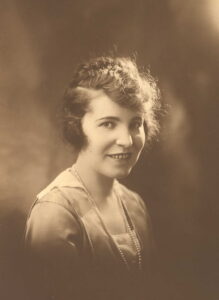
Ethel
At Fort Lewis, prior to shipping out, Leonard met Ethel Lenore Tanner, a lovely local girl from the Tacoma area. How they met is not recorded, nor is it known exactly how much time they had together prior to his deployment. What IS known is that they fell in love, and Leonard pledged to return from war and make Ethel his wife. She gave him a picture and asked him to think of her often, and write as much as he could, and Leonard would indeed write often.
In the ensuing year of 1918, as a battlefield medic, Leonard saw horrors and hardship that simply cannot be imagined. Just as surely, he thought constantly of Ethel, and she reported later that he would send letters whenever he could, pledging his love, and vowing to do whatever he could just to stay alive, so he could make it back home to her. She was his reason to survive. He carried her photograph in a breast pocket next to his heart.
He was sent with his Division to France, to the Argonne Forest, where some of the most brutal warfare the world has ever known was taking place. The Meuse-Argonne battle was the largest frontline commitment of troops by the U.S. Army in World War I, and also the deadliest. A large portion of the battle was trench warfare, with men on each side squared off against one another in trenches which were sometimes only a few dozen yards apart. Bullets were constantly whizzing overhead. To pop up out of a trench was to risk certain death. At times, as new assaults were mounted, it would devolve into the most brutal and-to-hand combat imaginable.
The Argonne forest offensive saw the first widespread use of the “Browning Automatic Rifle”. This was the first practical “machine gun” that allowed our soldiers the luxury of rapid-fire. Prior to that, it was one-shot at a time. The Browning was effective in two ways. Defensively, it allowed our soldiers the ability to more effectively stem the enemy advancing assaults. Offensively, it gave our troops their first real chance to have an advantage when advancing a line, of actually being able to outgun and overtake the enemy and gain territory.
But it also meant that the fighting became even more close-quartered, and the battlefield injuries and casualties even greater in number. As a battlefield medic in the Argonne Forest, Leonard saw more horrors and more continual action than medics in any other war up until that time ever could have imagined.
During the battles in the Argonne, and particularly during the frequent assaults, there was constant gunfire, cannon and artillery fire, and bayonet attacks as opposing troops clashed in the trenches, lobbed and dodged grenades, and donned primitive masks to stem the effects of mustard gas. The overall battle involved US forces equivalent to two full expeditionary armies… over 450,000 troops, most fighting in cramped trench warfare and occasionally packed in shoulder to shoulder. There were over 26,000 US troops killed and over 95,000 wounded.
The injuries in the Argonne offensive were often horrific. Battlefield amputations were commonplace. Over 122,000 casualties. It’s hard to imagine what it must have been like for the young battlefield medics like Leonard and his fellows.
The 91st Army Infantry Division out of Fort Lewis had adopted the 91st Psalm as the bible scripture that would keep them and give them strength during their deployment. Leonard had a copy of this, which became worn and ragged from the ravages of the battle, but he kept it in his pocket with the picture of Ethel. During breaks in the action, he would take out the Psalm and read it, and gaze upon Ethel’s picture and dream of getting back to her. In part, the Psalm reads:
You will not fear the terror of night, or the arrow that flies by day, nor the pestilence that stalks in the darkness, nor the plague that destroys at midday. A thousand may fall at your side, ten thousand at your right hand, but it will not come near you. You will only observe with your eyes and see the punishment of the wicked.
What must Leonard have observed with his eyes? Certainly it included, as the Psalm had promised, “ten thousand falling at his right hand.”
In the December 23, 1918 edition of the Evening Missourian (Columbia, MO) we read:
“IN ALL THE BIG BATTLES “
“Leonard Coatsworth Writes of “Nine Days of Hell”. First Sergeant Leonard Coatsworth, a former student in the School of Journalism of the University, writes from Belgium to the Missourian: “My service record gives me credit for St. Mihlel, and for the Argonne-Meuse offensive, and the advance on the Esault (Belgium). I went through nine days of hell in the Argonne. There and elsewhere in France and Belgium, I have seen, I believe, nearly every phase of open warfare. It has been a very remarkable experience, and I am deeply conscious of how privileged I have been to have had a part in this.”
Many did not return from Europe. Leonard saw dozens, if not hundreds of men he knew personally, men he had been through training with, fall in battle. He had lived in mud and filth and blood and the stench of war. He had buried friends (or abandoned them where they lay), treated wounds and injuries and amputations.
But he survived. And when the war ended, he came home as he said he would. He came home to Ethel, and home to finish his Journalism degree.
From “The Washington Newspaper”, September 1920, (the publication of the University of Washington Journalism School),
“Leonard Coatsworth, graduate in Journalism in the summer quarter, left immediately for the Montesano Vidette. (The daily newspaper of Montessano Washington) Mr. Coatsworth had three years of Journalism under Dean Walter Williams at the University of Missouri, and was two years with the Ninety-First Division, most of that time in France. Mr. Coatsworth was at Camp Lewis (Washington) before going overseas, and the Reason that brought him to this state after the war to finish up his journalism, will presently be with him in Montesano.”
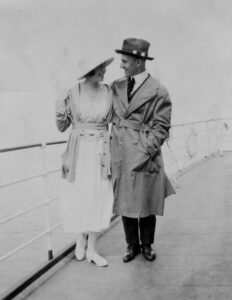 That “Reason”, of course, was Ethel. Ethel Lenore Tanner and Leonard Broughton Coatsworth were married on the 17th of January, 1921.
That “Reason”, of course, was Ethel. Ethel Lenore Tanner and Leonard Broughton Coatsworth were married on the 17th of January, 1921.
Despite being born to a proud family of lumber men, Leonard was a born journalist and word man. He took to his new profession with a passion and professionalism and dedication rarely seen. After a few years at the Montesano Vidette, he joined the staff at the Tacoma Daily Ledger as City Editor.
From the Morning Oregonian, Thursday August 24th, 1922, we find this curious piece about Leonard and his car full of golf caddies.
BIG BEAR REARS AT AUTO
Bruin Takes Possession of Road and Car Almost Ditched.
ABERDEEN. Wash., Aug. 23. (Special) A big black bear reared on its haunches on the Olympic highway, two miles east of Aberdeen, early this afternoon, and nearly caused at least one motorist to drive into the ditch in astonishment. Leonard Coatsworth of Montesano, coming to Aberdeen with a number of Country club caddies as passengers, nearly ran into the bear before it decided that it could not cope with an automobile. The animal dropped to all fours when only a few feet from the car, and ambled into the underbrush at the side of the road.
In 1925, Ethel gave birth to their only child, a daughter, Geraldine, whom they called Gerry. When Gerry was seven years old, in 1932, Leonard brought home a dog for a pet. The black mixed breed was mostly Cocker Spaniel, but from his very short legs, he obviously had some Dachshund in his lineage as well. The name Gerry picked out for the pup, a name that fit him perfectly, was Tubby. Tubby and Gerry were soon inseparable.
Tacoma is located on the banks of the backwaters of Puget Sound. The Coatsworths owned a small summer house in Arletta, a beach community on the shore of the peninsula opposite the city. They loved spending as much of their spare time there as possible, and often took the ferry across to Arletta on weekends. Leonard, Ethel, and Gerry. And of course, Tubby went along. At the beach house, Tubby considered himself the one that “ruled the roost”, and whenever Leonard and Ethel had guests over to the house, they had to first pass muster with Tubby.
Once when Gerry was swimming at the beach in Arletta, with Leonard and Tubby sitting on a blanket keeping an eye on her, Tubby actually saved her life. Leonard had turned away momentarily when Gerry stepped in a hole or a depression underwater, and the strong current dragged her under. Tubby started frantically barking, and alerted Leonard. Leonard could not attract the attention of the young teen lifeguard, who was flirting with some nearby teenage girls. He ended up plunging into the water himself, fully clothed, found Gerry, and dragged her to safety.
As a very upset father, he saw to it that the lifeguard was immediately dismissed. But he didn’t stop there. As a newspaperman with a “Bully Pulpit”, he wrote columns pointing out how ill-equipped the lifeguards in and around Tacoma were to do their jobs, and as a result became something of an activist, spearheading a campaign to call for mandatory training for lifeguards. This led to laws that were widely adopted, some of which are still in effect today.
Back home in Tacoma, the Coatsworth family lived on North 31st street, and a scenic path just across the street led down a big hill directly to Puget Sound. One day in 1935 when Gerry and her dad Leonard were out walking with Tubby, the dog rushed into traffic and was struck by a car. Tubby survived the accident, but it left him with a permanently stiffened and barely functional hind leg, causing him to limp everywhere he went.
When the Tacoma Daily Ledger suspended publishing in 1937, Leonard joined the Tacoma Tribune serving at various times as Copy Editor, News Editor, and Editorial Writer.
At the Tribune, Leonard …
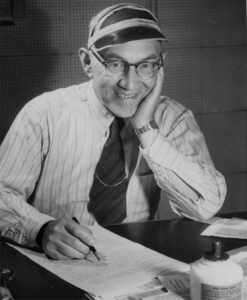 “… enjoyed a reputation as a talented newspaperman, the only one on staff who could cover a story, write it, edit it, set the press type, and even run the presses if necessary. His colleagues would say, “Don’t bother with the dictionary, just ask Leonard”.” (Columbia – The Journal of Northwest History, Summer 2007).
“… enjoyed a reputation as a talented newspaperman, the only one on staff who could cover a story, write it, edit it, set the press type, and even run the presses if necessary. His colleagues would say, “Don’t bother with the dictionary, just ask Leonard”.” (Columbia – The Journal of Northwest History, Summer 2007).
The closest point across the sound from the city to the peninsula where Arletta beach and the Coatsworth cottage was located, where the channel narrowed down, was called, appropriately, “The Narrows”. In 1938, construction began on the first ever bridge across the sound, at just this point. It was to be an engineering marvel – the longest, narrowest, lightest suspension bridge ever built. The center-span’s length to width ratio was 1::72. This far surpassed the previous record holder, the Golden Gate Bridge in San Francisco which had opened the previous year, 1937, and which had a length to width ratio of 1::47. The new bridge was considered to be a triumph of civil and mechanical engineering. Along with many others in the city, the Coatsworth family kept an eye on the construction progress and eagerly awaited the day there would be a bridge across the Sound, so they did not have to take the Ferry just to get across to their get-away cottage.
When the bridge opened in 1940, it was to great fanfare, parades, and celebration. It operated as a toll bridge, with toll booths at the entrance to the bridge on each side.
It was soon noted by those crossing the bridge that they could actually feel it swaying and rollicking in the wind. To the chagrin of the bridge designers, it was nicknamed, “Galloping Gertie”. The engineers claimed there was nothing to worry about, as the bridge had been specifically designed to withstand sustained winds in excess of 120 mph. This is equivalent to what we would today call a Category 3 hurricane.
As you may know, or may have guessed by now, that was not the case.
Many of the locals who regularly crossed the new bridge enjoyed the “thrill ride” of feeling their own cars, and watching the cars in front or behind, rise and fall with the undulating road bed when there was even a gentle breeze. Privately, the engineers who had designed the bridge were becoming more and more worried. The Toll Bridge Authority contacted Civil Engineers at the University of Washington to study the problem and devise a solution. In the late summer of 1940, the engineers revealed a plan to stabilize “Gertie”, with the addition of curved steel plates and beams which would be added to the sides of structure. This plan was accepted and the fabrication of the curved plates was begun.
None of them could know, though, that one of the most spectacular engineering failures of the twentieth century was imminent, and the plan to install the stabilizing plates would never come to fruition.
If you can remember back to the start of this very long story, back in “Part One”, I wrote about the newsreels we saw at the Liberty Theater on those Wednesday afternoon Summer Matinees back in Mexico, Missouri. One of those old newsreels we saw was the film of the epic failure of the Tacoma Narrows Bridge … the collapse where a relatively unremarkable wind took down the big suspension bridge known as “Galloping Gertie”. Watch a newsreel of the bridge collapse here:
Newsreel Footage Tacoma Narrows Bridge Collapse
As I watched that film, and even as I saw it occasionally through the ensuing years, shown sometimes in physics or mechanical engineering classes, I did not know that there was a connection between that epic engineering failure and my little hometown of Mexico, Missouri.
For you see, the last man to attempt to drive across the new Tacoma Narrows Bridge, “Galloping Gertie”, on the day that it collapsed, November 7, 1940, was none other than Mexico boy … journalist and wordsmith … Leonard Coatsworth. And the only casualty that day when the bridge fell was his daughter Gerry’s little dog, Tubby.
On the morning of November 7th, 1940, Leonard had planned to travel with Ethel over to their house in Arletta to do some routine maintenance to their getaway cottage, and to begin the yearly process of “winterizing” it to withstand the upcoming Pacific Northwest winter. At the last minute, Ethel decided to stay at home in Tacoma. So Leonard, in their 1936 Studebaker, with Tubby riding along like a chauffeured aristocrat in his usual back-seat position, headed out towards the Sound and the fateful, last-ever attempt anyone would ever make to cross Galloping Gertie.
By mid-morning, the winds had kicked up a bit, and were blowing with gusts up to about 42 mph, racing through the Sound. It was right at 10 am when Leonard paid his toll and drove west onto the bridge. As he passed the bridge’s east tower, bridge span, and the road-bed began to suddenly sway and twist rather violently, in a fashion that Leonard had never experienced before in his many bridge crossings.
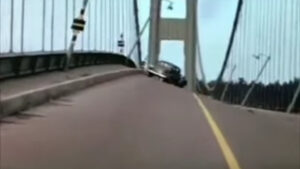
Leonard’s Studebaker on the violently twisting bridge
The bridge was tilting as much as 30 feet back and forth, to one side then the other. It was impossible to drive. With Leonard still behind the wheel, the car slid back and forth, was tossed about, and eventually slammed into the opposite curb. Driving was impossible. Leonard realized he simply would not be able to cross the bridge, and decided to abandon the car and get off the bridge and wait it out. He got out of the car, and attempted to remove Tubby from the backseat.
The little dog was frightened and highly agitated though, and uncharacteristically snarled and snapped at Leonard. He decided that the safest thing for Tubby was to let him remain in the back seat until he could return to the car and get them both safely across to the other side.
Leonard began to try to get himself off the bridge. He would stumble a few steps on the violently undulating structure, then be thrown unceremoniously to the pavement like a rag doll. He crawled, stumbled, and dragged himself along as best he could, holding on to the curb at times for dear life. He was tossed into the air more than once. In the occasional few moments of relative calm between lurches of the structure, he would be able to crouch and run a few steps, then the bridge would twist and buck, and he’d be thrown to the ground again.
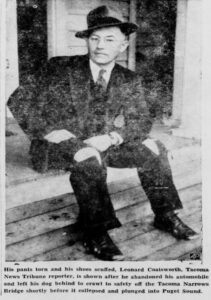
Leonard with pants torn and shoes scuffed.
Reaching the toll plaza eventually, Leonard collapsed, bloody, shaken, bruised and battered. Pants torn, shoes scuffed. There a small crowd had gathered, watching the twisting bridge with fear and wonder. Leonard’s had been the last car through the toll booth on either side.
Ever the newsman, Leonard went to a phone booth in the park at the base of the bridge, and called the Tribune, who immediately dispatched a photographer, Howard Clifford, and a reporter. On the way to the bridge, along Sixth Avenue they passed a large, bright billboard advertising Pacific National Bank as “secure as the Narrows Bridge”. As they were in quite a hurry to get to the bridge before it collapsed they made a note to themselves to photograph this billboard on their return. But by that time they pass that way again later in the day, they found that slogan had hastily been painted over and removed. It was no longer the message the bank wished to convey to its investors…
Back at the toll booth entrance to the bridge, as others continued to gather to watch the bridge, the undulating and twisting continued for the better part of an hour. A couple of film crews arrived, which is why we have the amazing footage still today of the collapse. Footage which gets shown and re-shown and analyzed in Civil Engineering classes to this day. One of the men who showed up when the reports that the bridge was in serious and potentially devastating oscillation was F. Burt Farquharson, the Professor of Civil Engineering that had come up with the as yet unrealized plan to stabilize the bridge. He and Clark Eldridge, Chief Engineer for the Toll Bridge Authority watched helplessly with sinking hopes for the bridge, unable to do anything at all to stop or quell the motion. In a moment when the bridge was relatively calm, Farquharson ran out onto the structure, against the protests of those standing by. Perhaps with the mindset of a typical engineer, he simply wanted to see the twisting structure better up close, in hopes it would further inform his opinions of what might be done to stabilize it in the future.
He made his way out as far as Leonard’s Studebaker, and heard the highly agitated Tubby still in the back seat. Farquharson tried to retrieve the dog, but Tubby was scared, and ended up biting the engineer’s hand, drawing blood. With the bridge starting again to sway and creak and make dangerous sounds of structural stress, the engineer decided to leave Tubby and get back to safety himself.
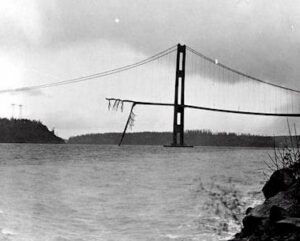
The Collapsed Bridge
Just as he was clearing the towers and back to a safer point, after nearly an hour of violent motion, the bridge was simply unable to withstand the stresses and it spectacularly began to break up. Huge parts of the superstructure and the road-bed twisted and fell to the churning water 190 feet below.
Plunging to the water along with the bridge was Leonard and Ethel’s 1936 Studebaker. Inside, sat Gerry Coatsworth’s beloved pooch, Tubby. He was only casualty of the day.
Continuing on the phone with his newspaper, Leonard dictated a story in a shaky voice, having made no notes, composing simply off the top of his head, borne of his lifetime of experience as a wordsmith. It begins, “I saw the Narrows Bridge die today, and only by the grace of God escaped dying with it. …”
The story was printed in the paper the next day, and would be picked up and reprinted in newspapers around the world.
Story filed by Leonard Coatsworth, November 7, 1940 just after being the last driver to attempt to cross the Tacoma Narrows Bridge.
I saw the Narrows Bridge die today, and only by the grace of God escaped dying with it.
I have been near death many times in my life, but not even in my worst experiences in France did I experience the feeling of helpless horror that gripped me when I was trapped on the bridge this morning.
Before starting over the bridge I had driven underneath the approach to watch the motion. The undulations were more rapid than I had ever seen before. This, however, was the only difference I saw from other times when a strong breeze was blowing.
I drove on the bridge and started across. In the car with me was my daughter’s cocker spaniel, Tubby. The car was loaded with equipment from my beach home at Arletta. Not until I reached the first towers did I realize something was terribly wrong.
Either just as I reached the towers or just as I drove past them, the bridge began to sway violently from side to side. This was something new in my experience with the bridge. Heretofore, the noticeable motion has been up and down and undulating.
Before I realized it, the tilt from side to side became so violent I lost control of the car and thought for a moment it would leap the high curb and plunge across the sidewalk of the bridge and into the railing.
I jammed on the brakes and got out of the car, only to be thrown onto my face against the curb. I tried to stand and was thrown again. Around me I could hear the concrete cracking.
I started back to the car to get the dog, but was thrown before I could reach it. The car itself began to slide from side to side on the roadway. I decided the bridge was breaking up and my only hope was to get back to shore.
On hands and knees most of the time I crawled 500 yards or more to the towers. Across the roadway from me I became aware of another man, apparently crawling and then running a few steps in a crouched position.
My breath was coming in gasps, my knees were raw and bleeding, my hands bruised and swollen from gripping the concrete curb. But I was spurred by the thought that if I could reach the towers I would be safe.
Finally, my breath gave out completely and I lay in the roadway clutching the curb until I could breathe again, and then resumed my tortuous progress.
Those who stood on the shore and watched the bridge in its death agony still have no conception of the violence of the movement felt by one out beyond the towers. Safely back at the toll plaza, I saw the bridge in its final collapse and saw my car plunge into the Narrows.
I saw Clark Eldridge (Toll Bridge Authority engineer), his face white as paper. If I feel badly, I thought, how must he feel?
And always through the back of my mind ran the thought – why did I not save my dog? But I know I would have lost him on the way in.
With real tragedy, disaster and blasted dreams all around me, I believe that right at this minute what appalls me most is that within a few hours I must tell my daughter that her dog is dead, when I might have saved him.
There is an off-leash dog park now in the shadow of the new bridge, same location as the old bridge, and it has been named in honor of Tubby. There is a plaque there honoring the frightened Spaniel who plunged to his death that fateful November afternoon.
After the bridge collapse and the notoriety he gained therefrom, Leonard returned to the life of a respected newspaperman in Tacoma, and to the life of a family man with Ethel and daughter Gerry. Leonard Coatsworth lived only to the age of 61, passing in November of 1956.
Leonard’s Obituary:
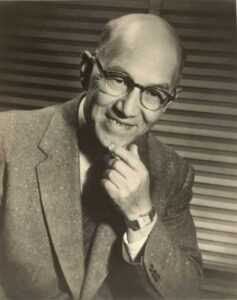 November 26, 1956. Tri-City Herald, Tacoma WA. – Leonard B. Coatsworth, who retired June 30 after 34 years’ service with The Ledger and News Tribune, died at his home here Sunday. He was 61. Coatsworth was a correspondent for the old Daily Ledger in the Montesano area in 1921 when the paper brought him to Tacoma as an assistant city editor. He later became city editor and was news editor of The Ledger when publication was suspended in 1937. Coatsworth then joined The Tacoma News Tribune staff, serving at various times as copy reader, news editor and editorial writer. He won national prominence in 1940 when the first Narrows Bridge collapsed. Driving to his summer home at Arietta, he was caught on the twisting span and made his way back to the Tacoma end of the bridge on his hands and knees. His copyrighted story of “Galloping Gertie’s” collapse received national attention, and he was flown to New York to appear on a nationwide radio program.
November 26, 1956. Tri-City Herald, Tacoma WA. – Leonard B. Coatsworth, who retired June 30 after 34 years’ service with The Ledger and News Tribune, died at his home here Sunday. He was 61. Coatsworth was a correspondent for the old Daily Ledger in the Montesano area in 1921 when the paper brought him to Tacoma as an assistant city editor. He later became city editor and was news editor of The Ledger when publication was suspended in 1937. Coatsworth then joined The Tacoma News Tribune staff, serving at various times as copy reader, news editor and editorial writer. He won national prominence in 1940 when the first Narrows Bridge collapsed. Driving to his summer home at Arietta, he was caught on the twisting span and made his way back to the Tacoma end of the bridge on his hands and knees. His copyrighted story of “Galloping Gertie’s” collapse received national attention, and he was flown to New York to appear on a nationwide radio program.
So there you have it. As I said out the outset, I have been fascinated … obsessed really … with Leonard’s story for quite some time. I’m not exactly sure why. Certainly the random fact of his experience with the Narrows Bridge, being a hometown boy, is what drew me in initially. But as I found more and more clippings, it got more and more interesting. It allowed me to glimpse him through the years … from a young boy experimenting with wireless radio in the earliest days of that medium, to an avid Boy Scout, in the earliest days of Scouting, to his incredible hike with his friends from Mexico to St. Louis, to his growing expertise as a debater and orator, to going off to college and pulling the “photo prank” and his experiences at my alma mater Mizzou, to his joining Chatauqua, joining the army and meeting Ethel and their love for one another, going off to the First World War with her photo in his pocket, seeing some of the deadliest and most devastating hand-to-hand warfare ever and treating those wounds as a battlefield medic, to returning home to his true love Ethel, and on to the bridge collapse and poor little Tubby, and beyond.
Maybe many … or even most…. lives are that remarkable when you unpack them? I don’t know. But I do know this: The idea of Leonard and his friends Morris Dry and Minter Bragg and all the others walking the streets of my hometown, Mexico, Missouri, and seeing some of the same stores I remember as a child, visiting the same railroad depot, playing and camping in some of the same woods, fishing in the same lakes …. Somehow that just makes me happy. The idea that they were there doing those things a full sixty years before me gives me some kind sense of comfort about the continuity of things. And the idea that Leonard’s nephew was there for me in my moment of need…. to loan me the 50 cents I needed to get into the cool darkness of the Liberty Theater on a blistering day, to “be a kid” on a summer afternoon …. That makes me smile from the inside out.
I hope you’ve enjoyed this journey through my childhood in Part I, and through a bit of Leonard’s life in Part II. As I said at the outset, I draw no particular parallels, other than the fact that we grew up in the same place, at different times, and both had grand adventures.
So here’s to the adventures of childhood. Here’s to the neighborhoods and towns and cities that made us who we are. And here’s to the ordinary moments of life. Moments that when viewed in the rear-view mirror turn out to be not so ordinary at all.
And here’s to Tubby.
love,
John

